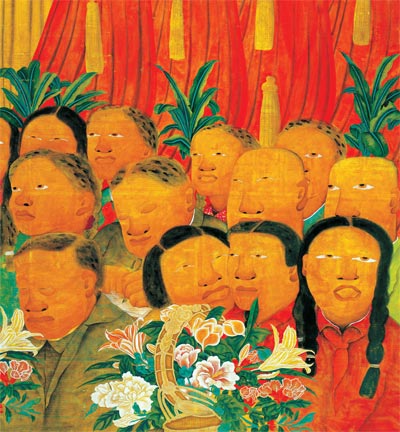Ink painting today
Many ink painters find it hard to depict contemporary life with their traditional tools of rice paper, black soot–based ink and bamboo-handled brushes. To overcome the obstacle, artists young and old are devoting themselves to innovating the ancient art form, both in subject matter and technique.
 |
|
Contemporary ink painting Utopia No. 57 by Zhu Wei. [Global Times] |
There is a gradually growing interest in contemporary ink painting both within China and abroad, with the introduction of modern styles as a unique way to celebrate the old art form while acknowledging an ever-changing society and artistic style, according to independent art critic Liu Siyan.
"Ink paintings need to advance with the times," Liu told the Global Times, adding that the developments are important in preserving China's artistic heritage. "Only this way can Chinese traditional art sustain its vitality and at last come to the eyes of the public," Liu said.
Far from the landscapes, flowers and birds that dominate traditional ink painting, it is now common to see modern figures with faces or scenes from China's recent history in contemporary works, such artistic innovation allowing artists more freedom to reflect the times they are living in.
Depicting modern subjects is giving ink painting renewed popularity, artist Zhu Wei told the Global Times. Heavily collected for his contemporary ink pieces both at home and abroad, Zhu said that he has long been interested in new interpretations of the ancient art form. "Artists should reflect the society they are living through, no matter whether it is beautiful or not," he said.
Born in 1966 in Beijing, Zhu is among the first Chinese artists whose works were largely bought by Western collectors in the early 1990s.
Using both materials and techniques of traditional ink painting, which are generally considered only proper for depicting landscapes, figures and flowers as was done in ancient times, Zhu began his innovation by deliberately portraying scenes from his childhood, which coincided with the Cultural Revolution (1966-76).
With a deep understanding of ancient ink paintings and their creators from differ-ent dynasties, Zhu adeptly integrates tradition and the contemporary in his subjects, often juxtaposing ancient and modern elements, with the aim to offer reflections on Chinese life and society.
His well-known series Utopia features people with huge heads on sturdy bodies, participating in official meetings. In a sequence of as many as 50 paintings, these officials listen with respect and boredom, sometimes dutifully taking notes with stubby fountain pens. Here a basket of flowers in each painting is adapted from Song Dynasty (960-1279) master Li Song's album of figures, which deliberately fits well with other contemporary elements in the painting.
In Zhu's eyes, ink painting has been the most fashionable art genre for thousands of years and ink painters from every dynasty have tried to develop the art form with the times. "What makes the difference is just what is favored now is no longer only landscapes, birds and flowers and the female figures that used to be very popular before," Zhu explained.
"I do not agree with many art critics' opinions that traditional ink painting cannot keep pace with today's fast developing society," he added. "I guess that some artists are just overwhelmed by traditional masterpieces, fearing that there is no way to surpass them.
"Others are just seeking instant economic benefit so they can't calm down and look back to our tradition."
Zhu said that in order to create an excellent contemporary ink painting, artists must first have a profound understanding of traditional ink painting and then carefully observe complicated modern-day life.
Most contemporary ink painters start out in the traditional school, agreed Wu Yi, a professor at the Central Academy of Fine Arts, who has also made significant achievements in ink painting. He told the Global Times that few artists ever expect to go beyond the scope of traditional ink painting when they begin to learn.
Wu said that he believes that with more efforts being made by painters and educators to move the genre forward with the times, things will get better and better. "I myself am confident in ink painting, since it perfectly integrates tradition and contem-porary, which is amazing."
 0
0 






